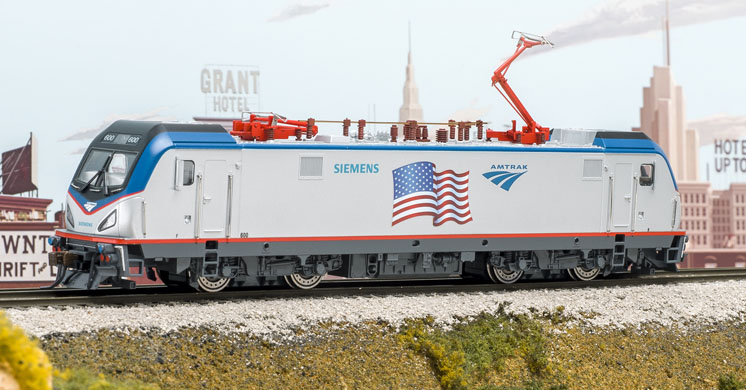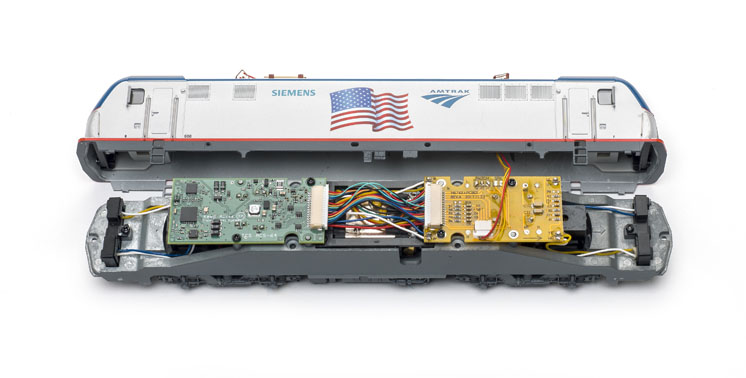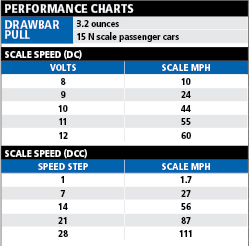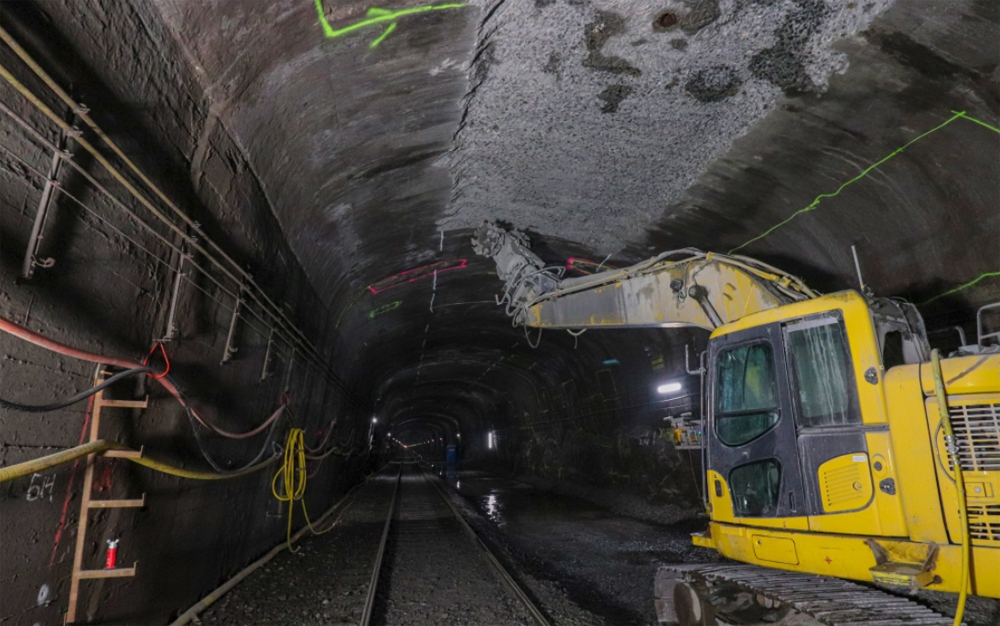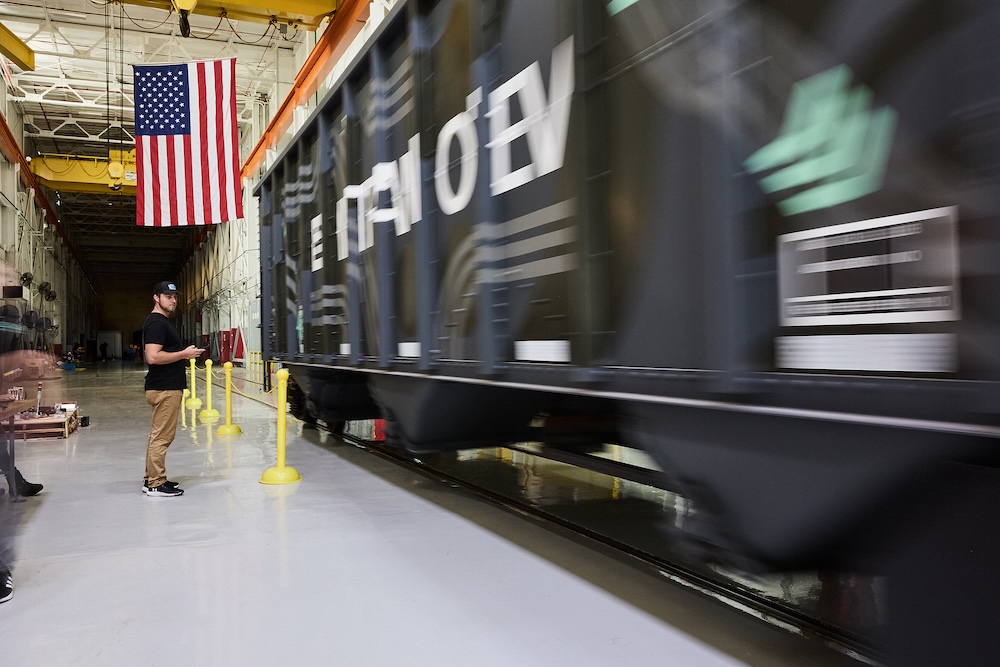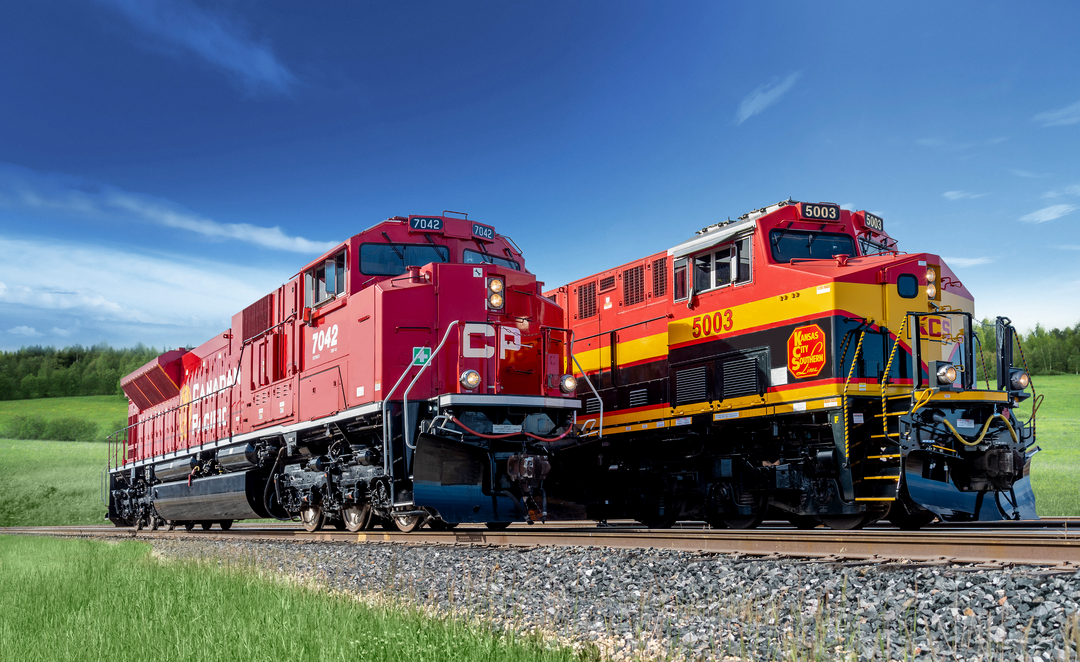Amtrak’s ACS-64 Cities Sprinter has been rushing passengers up and down the Northeast Corridor for nearly five years, including a stretch not far from the Bachmann Industries headquarters in Philadelphia. Now you can add it to your layout with Bachmann’s latest sound-equipped HO scale release.
The prototype. The Amtrak Cities Sprinter (ACS) 6,400kW (the -64 in the name) is a high-speed electric locomotive designed to accelerate 18-car Amfleet trains to 125 mph in about 8 minutes. The locomotives were built in Sacramento, Calif., by Siemens and are based on the EuroSprinter locomotives used overseas.
Modifications for Amtrak use include “Tier I” crash compliance to better protect locomotive crews at high operating speeds. The locomotives also accept three different operating voltages, ranging from 12,000V to 25,000V and either 25 or 60hz, the legacy of the four builders of the Northeast Corridor infrastructure the Pennsylvania RR; the New York, New Haven & Hartford; New York Connecting RR; and Amtrak.
But these locomotives don’t just draw power from the overhead wire; they also put it back with regenerative braking. Up to 5 megawatts can be sent back into the catenary during braking, eliminating the need for resistor grids and cooling fans, and saving Amtrak more than $300 million in electricity charges over the first 20 years of ACS-64 operation.
The 70-locomotive order was built to meet a 51 percent U.S.-made standard. Besides locomotive fabrication in California, Siemens made major components of the traction system at plants in Georgia, Ohio, and Mississippi. New York Air Brake and toilet and ventilation vendors are other U.S. manufacturers involved in the project.
Revenue service began in February 2014, and final delivery of the 70-unit order occurred in August 2016. In addition to the 70 Amtrak units, Siemens also built 15 units for the Southeastern Pennsylvania Transportation Authority (SEPTA) for suburban Philadelphia service. The first SEPTA unit was delivered in December 2017 and entered service in July 2018.
For Amtrak, the 6,700 hp ACS-64s replaced the venerable AEM-7s, which entered service in 1979, and the less-well-regarded HHP-8s, launched in 2000. SEPTA is replacing its aging AEM-7/ALP-44 fleet as the ACS-64s are delivered.
The model. Bachmann’s ACS-64 has an injection-molded plastic body mounted to a die-cast metal frame. A flywheel-equipped can motor in the center of the frame powers all eight wheels, which also all pick up current. A switch on the bottom of the locomotive allows the metal pantographs to collect electricity.
Grab irons and handrails are separately applied bright metal parts, and other separate details include the large windshield wipers and flush mounted glazing on all the windows and light covers. Underbody details feature more separate parts, including bits of piping and sensors for safety equipment.
The control desk in the cab is clearly visible, and two seats await crew figures. The turned-metal wheelsets have the distinctive brake detailing on their faces, and the pilots are adorned with m.u. hoses and receptacle covers picked out in red, blue, or black colors as appropriate.
Our sample was painted to represent class unit no. 600 in its demonstrator scheme with large American flags on the sides. The unit has since been repainted with the Amtrak logo and large unit numbers on its sides.
The pantographs lock down securely, yet are easy to release and seem sturdy enough to stand up to operation without looking out of scale. Other roof detailing includes insulators and bus wires, along with a pair of five-chime horns. The air conditioners and other piping and roof vents are molded on. A bit of weathering would really make the detail there pop.
Overall dimensions were within a few scale inches of measurements printed on the Siemens ACS-64 page I found online.
TCS WOWSound. Packed with new technology, Bachmann’s ACS-64 model debuts Train Control Systems’ (TCS) WOWSound Electric dual-mode decoder. There’s no straight direct-current (DC) version offered.
The WOWSound decoder requires filtered DC power to operate correctly in analog mode. Out of the box, our review sample ran flawlessly with a Bachmann no. 44211 power pack.
Using older rheostat or “pulse” power packs with the WOWSound decoder can result in unreliable operation. If the locomotive runs erratically in DC, the simple solution is to add a DC filter.
I wired a TCS AF1 Analog Filter ($23.95 at www.tcsdcc.com) to our test track and the ACS-64 ran smoothly with our workshop’s MRC Tech 4 power pack.
Start-up sounds commenced at 7V, and the locomotive began to move at 8V at 10 scale mph. At 12V, our maximum testing voltage, the locomotive reached 60 scale mph. But the power pack had more to give, and at its maximum, 15.5V, the locomotive raced along at 144 scale mph.
But the TCS WOWSound decoder really shines on Digital Command Control (DCC). At speed step 1, the locomotive crawled along at 1.7 scale mph, perfect for gently coupling to a passenger train. At speed step 28, it reached 111 scale mph, plenty fast enough for most layouts.
But what about the sound, you say? After a start-up sequence that includes the sound of electricity arcing from the catenary to the pantograph, compressor sounds pump up the air and blower fans hum. Increasing the speed setting starts the traction motors whining.
Pressing function button 4 generates the high-speed flyby “Whoosh” of an Amtrak Northeast Regional train roaring past. A playable horn sound at F2 made sounding grade-crossings fun. And at F8, double clicks allow access to lighting functions and functions above F9 without having to remap favorites down lower. I especially liked that I could illuminate the ditch lights and marker lights with separate key commands, and that the ditch lights flash when the horn is sounded.
Four clicks on F8 allows the user to enter Audio Assist, TCS’s menu-driven configuration tool. I used Audio Assist to remap the headlight controls so I could turn the headlights on and off depending which way the locomotive was going.
The factory-programmed lighting had both lights on at all times, with the light in the direction of travel bright, and in the opposite direction dim. I wanted the light off in the opposite direction of travel, so I remapped the rear light to F4 in place of the whoosh sound effect. This allowed me to control the lights independently.
In addition to sound and lighting options, I found the switching/mainline momentum toggle at F16 to be useful for varying the amount of momentum based on whether the locomotive was moving by itself or pulling a train. The WOWSound Electric decoder also supports TCS’s brake function.
Although we have no catenary strung, I took the ACS-64 to our staff layout, the Milwaukee, Racine & Troy, for further testing. The locomotive easily tracked around curves and negotiated no. 6 turnouts and crossovers. Our draw-bar test meter showed the ACS-64 is capable of exerting 3.2 ounces of force, equivalent to 15 free-rolling passenger cars on straight and level track.
If you’re a fan of modern passenger power, this well-detailed and smooth-operating high-speed locomotives might be just the ticket. Adding in the prototype sound and lighting features of TCS’s WOWSound Electric decoder makes a great model even better.
Manufacturer
Bachmann Industries Inc.
1400 E. Erie Ave.
Philadelphia, PA 19124
www.bachmanntrains.com
Era: Feb. 2, 2014 to present
Roadnames: Amtrak demonstrator, Amtrak (two road numbers), Amtrak Salutes our Veterans, Southeastern Pennsylvania Transportation Authority (one road number)
Features
• All-wheel-drive and electrical pickup
• Bachmann E-Z Mate plastic knuckle couplers at correct height
• Die-cast metal frame
• Directional, dimmable headlight
• Dual-mode TCS WOWSound decoder
• Flywheel-equipped can motor
• Metal grab irons and handrails
• Operating ditch lights
• Operating marker lights
• Minimum radius: 22″ or greater
• Switch for rail or pantograph power
• Weight: 1 pound, 9 ounces





